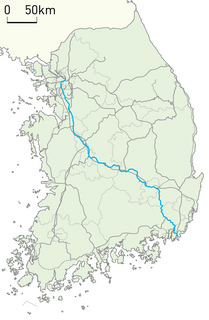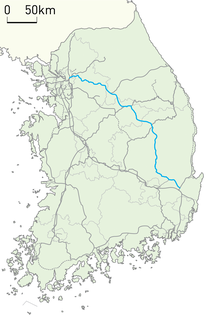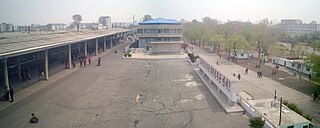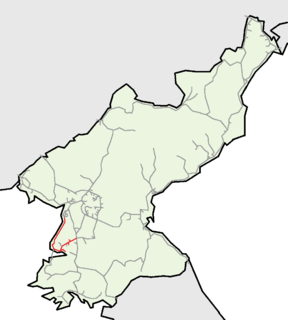
The South Manchuria Railway, officially The South Manchuria Railway Company, Ltd., Mantetsu or Mantie for short, was a large National Policy Company of the Empire of Japan whose primary function was the operation of railways on the Dalian–Fengtian (Mukden)–Changchun corridor in northeastern China, as well as on several branch lines.

The Gyeongbu Line (Gyeongbuseon) is a railway line in South Korea and is considered to be the most important and one of the oldest ones in the country. It was constructed in 1905, connecting Seoul with Busan via Suwon, Daejeon, and Daegu. It is by far the most heavily travelled rail line in South Korea.

The Gyeongin Line (Gyeonginseon) is a railway mainline in South Korea, currently connecting Guro station in Seoul and Incheon. Commuter services along the line through operates into Seoul Subway Line 1.

The Jungang line is a railway line connecting Cheongnyangni in Seoul to Moryang in Gyeongju in South Korea, traversing central South Korea from the northwest to the southeast. It is also referred to the rail line of the Seoul Metropolitan Subway from Yongsan station to Jipyeong station. The section from Cheongnyangni to Dodam was designated as a higher-speed railway.

The Gyeongui Line is a railway line between Seoul Station and Dorasan Station in Paju. Korail operates the Seoul Metropolitan Subway service between Seoul Station and Dorasan Station.

Sinŭiju is a city in North Korea which faces Dandong, Liaoning, China across the international border of the Yalu River. It is the capital of North P'yŏngan province. Part of the city is included in the Sinŭiju Special Administrative Region, which was established in 2002 to experiment with introducing a market economy. In recent years, the city, despite lagging behind the development in the capital Pyongyang, has seen a small construction boom and increasing tourism from China.

Dongdaegu Station, meaning "East Daegu Station", is a railway station in Daegu, South Korea. It is on the national high-speed KTX railway network, 282 km (175 mi) south of Seoul Station.

Dorasan station is a railway station situated on the Gyeongui Line, which used to connect North Korea and South Korea and has since been restored. Dorasan station is located approximately 650 meters from the southern boundary of the Korean Demilitarized Zone and is currently the northern terminus of Korail's Gyeongui-Jungang Line, which is served by Shuttle Service to Imjingang Station. North of here the former Gyeongui Line continues as the Korean State Railway's P'yŏngbu Line, but this connection is not in regular service. The current purpose of the station is largely symbolic of the hope for eventual Korean reunification.

The P'yŏngŭi Line is an electrified main trunk line of the Korean State Railway of North Korea, running from P'yŏngyang to Sinŭiju on the border with China. It is the main corridor for overland traffic between North Korea and China, and is one of the country's most important rail lines. A bridge over the Yalu River connects Sinŭiju to the Chinese city of Dandong and the Shendan Line of the China Railway to Shenyang and Chinese points beyond.

Iksan station is on South Korea's high-speed KTX railway network, 243 km south of Yongsan station.

Pyongyang station is the central railway station of P'yŏngyang, North Korea. It is located in Yŏkchŏn-dong, Chung-guyŏk.

Ryongch'ŏn station is a railway station in Ryongch'ŏn-ŭp, Ryongch'ŏn County, North P'yŏngan Province, North Korea. It is the junction point of the P'yŏngŭi and Tasado lines of the Korean State Railway.

Sinuiju Chongnyon station, also known as Sinŭiju Ch'ŏngnyŏn station, is a railway station in Yŏkchŏn-dong, Sinŭiju-si, North P'yŏngan Province, North Korea. It is the northern terminus of the P'yŏngŭi Line of the Korean State Railway, and the starting point of the Kang'an Line, which is an industrial line serving the factories of Sinŭiju.

The Korean State Railway, commonly called the State Rail is the operating arm of the Ministry of Railways of North Korea and has its headquarters at P'yŏngyang. The current Minister of Railways is Chang Jun Song.

The P'yŏngnam Line is an electrified standard-gauge trunk line of the Korean State Railway in North Korea, linking P'yŏngyang with the port city of Namp'o and the hot springs at P'yŏngnam Onch'ŏn. The length of the line is 89.9 km (55.9 mi).
Rajin station is a railway station in Rajin-guyŏk, Rasŏn Special City, North Korea. It is the junction point and terminus of both the Hambuk and P'yŏngra lines of the Korean State Railway. It is also the starting point of a freight-only branchline to Rajin Port station.
Ch'ŏngjin Ch'ŏngnyŏn station is the central railway station in Ch'ŏngjin-si, North Hamgyŏng Province, North Korea. It is the junction point of the Hambuk Line and the P'yŏngra Line of the Korean State Railway, and is the beginning of the Ch'ŏngjinhang Line to Ch'ŏngjin Port.
High-speed rail service in South Korea began with the construction of a high-speed line from Seoul to Busan in 1992, and was inspired by Japan's Shinkansen. The first commercial high-speed rail service was launched on April 1, 2004. Currently, South Korea hosts two high-speed rail operators: Korea Train eXpress (KTX) and Super Rapid Train (SRT).
Sŏp'yŏngyang station is a railway station in Sŏsŏng-guyŏk, P'yŏngyang, North Korea. It is on located on the P'yŏngra and P'yŏngŭi lines of the Korean State Railway.
Hyesan Ch'ŏngnyŏn station is the central railway station of Hyesan city, located in the Ch'un-dong neighbourhood of greater Hyesan city, Ryanggang province, North Korea. A large station with seven tracks, it is the junction point of the Korean State Railway's Paektusan Ch'ŏngnyŏn and Pukbunaeryuk lines.














